The Great Hurricane of 1938
Mystery writer Scotti (The Hammer’s Eye, 1988, etc.) applies her suspense-building skills to the story of a murderous storm that capped a punishing decade.
It’s hard to go wrong with the raw material provided by the Great Hurricane of 1938. The narrative follows the storm as it made landfall in Florida, pushed up the coast, and raced from Cape Hatteras to Long Island in a mere seven hours. Where appropriate, Scotti adds brief background material on the nature of hurricanes, the quality of weather forecasting at the time, and the histories of the towns hardest hit, particularly in Rhode Island; she also compares the 1938 storm to others in the past. But she saves her most powerful writing for the hurricane itself, describing the storm watch and the havoc wrought when it reached land with the help of a wide sampling of firsthand accounts. “The scene around us in the attic was unbelievable,” recalls a woman who was ten at the time. “The waves, at the level of the attic floor, beat unceasingly against the house, which trembled and shook.” Scotti matches the wild images of the eyewitness accounts with her own flair for descriptive narrative: “The ocean banged on doors and windows . . . then it went upstairs into the bedrooms where families sought refuge, and chased them higher yet, into third floors and attics, onto rooftops, until there was no place to go but into the sea.” Almost 700 people died, 433 of them in Rhode Island, where the storm surge buried Providence under 12 feet of water and where Scotti concentrates her story. With power and phone lines down, it was days before people understood the full extent of the devastation, which along the shoreline in particular was complete: “What they eye saw, the mind could not process and the heart refused to accept.”
A darkly intense portrait. (16 pp. b&w photos, not seen, 4 maps)
Kirkus

